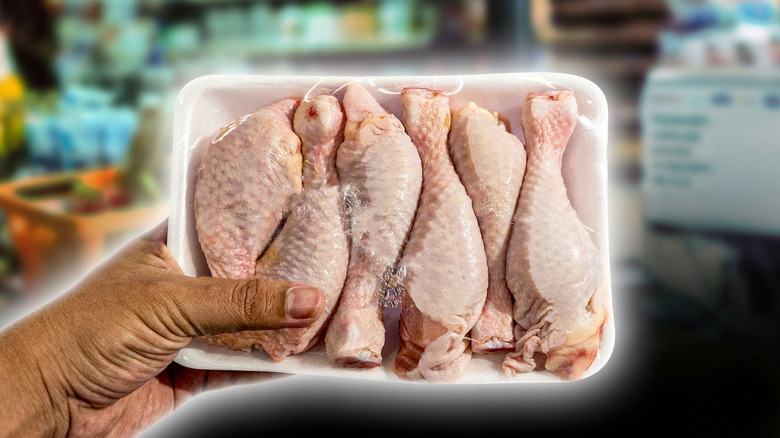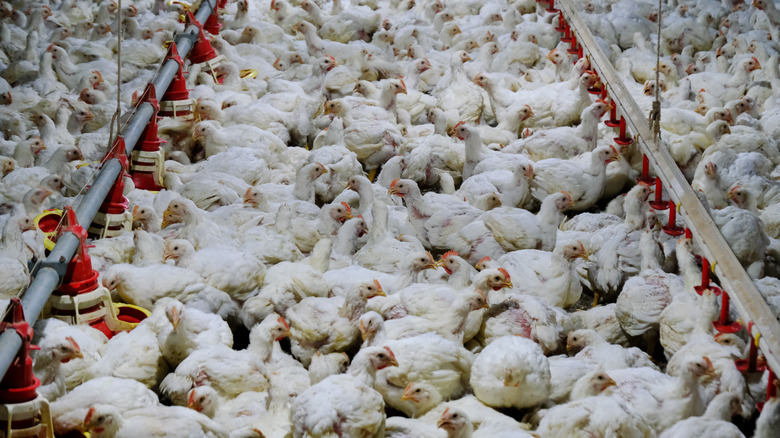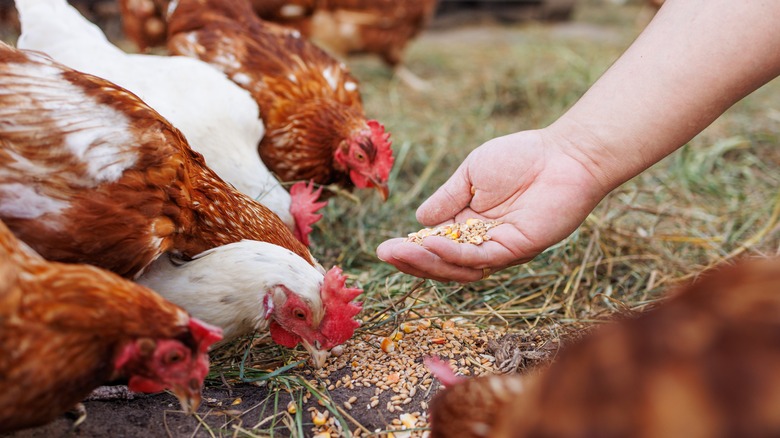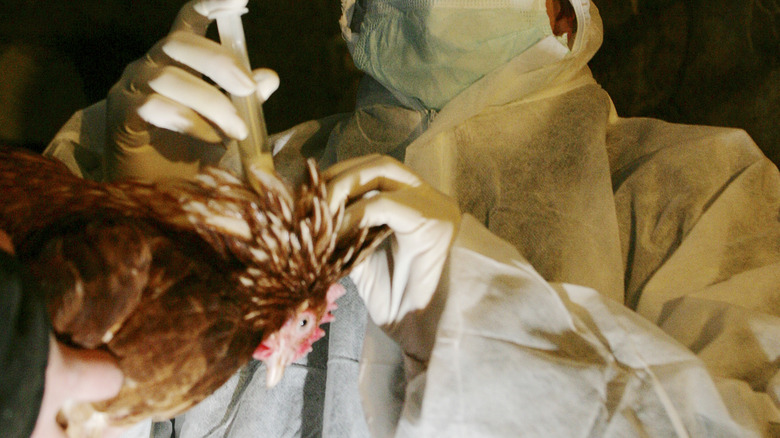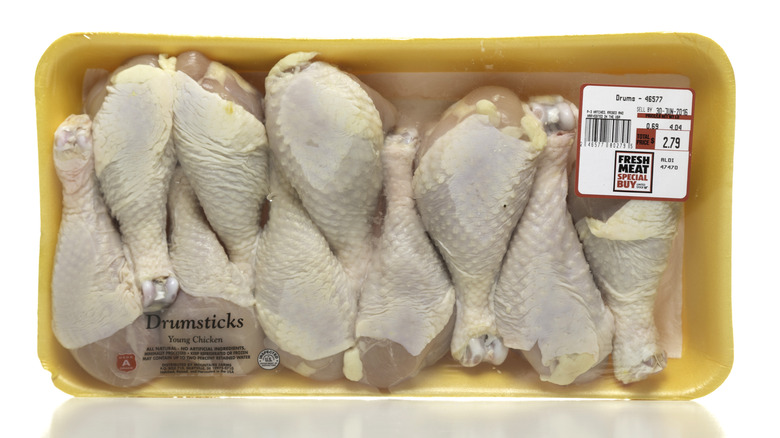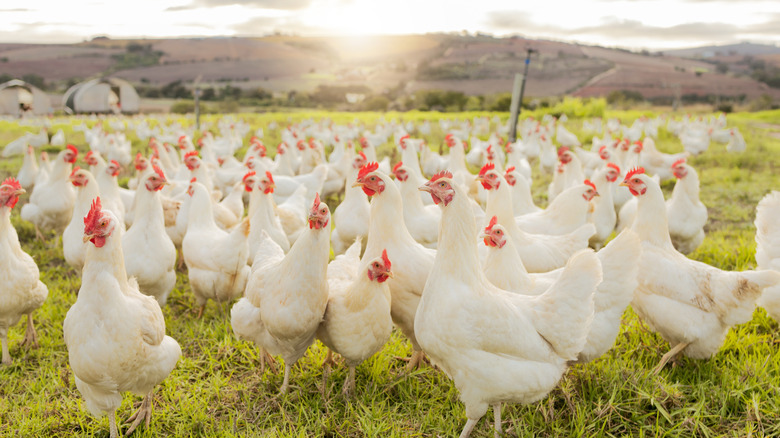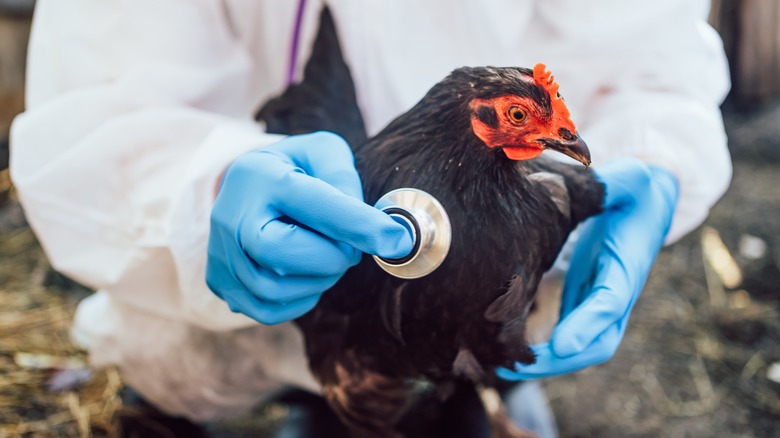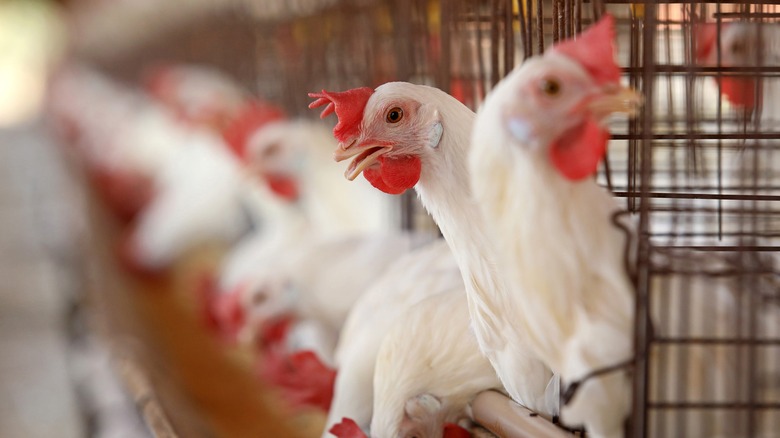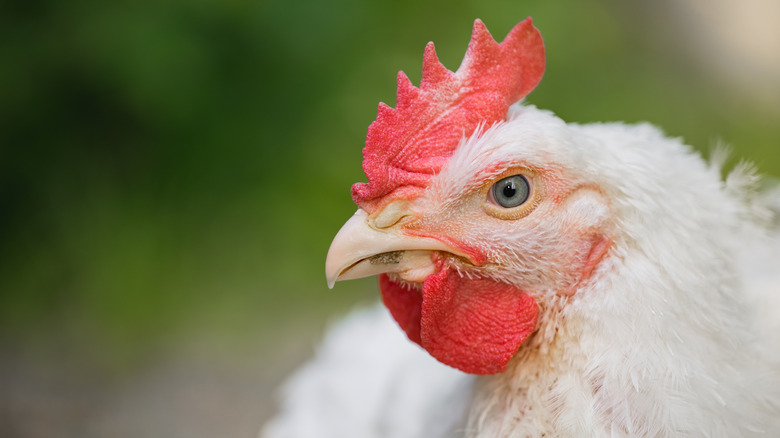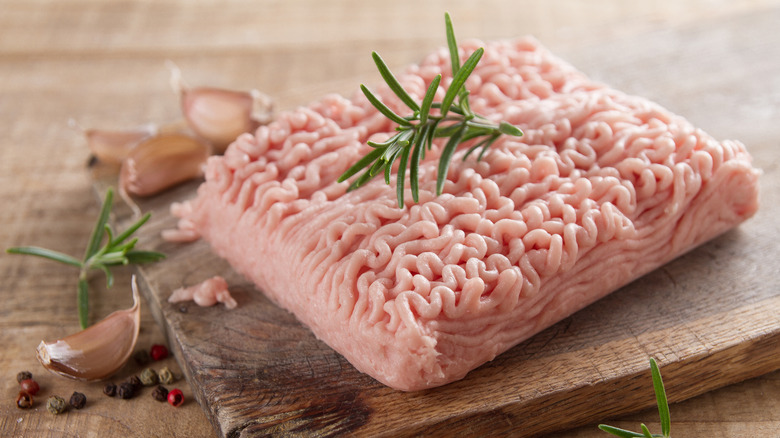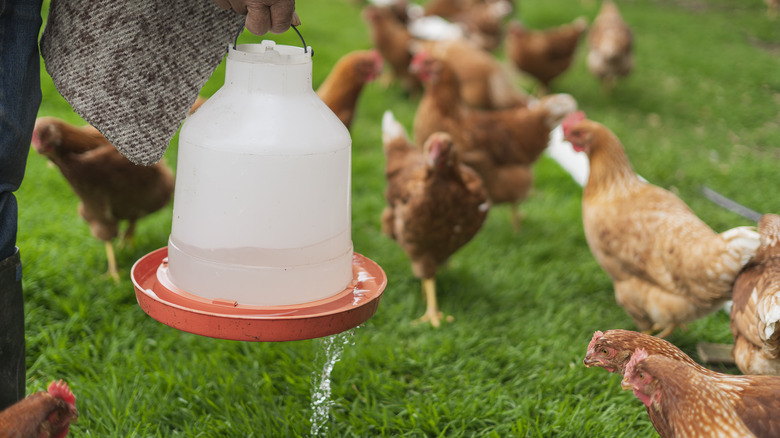The Worst Secrets Of Grocery Store Chicken Exposed
Chicken may be the most speculated-about item in the world of grocery shopping. The mystery of what happens to birds before they're wrapped, how much bacteria they spread around your kitchen, what sorts of intestinal trouble you might find if you don't cook chicken properly — every aspect of sold-by-the-pound poultry seems to have been the subject of scrutiny at some point.
For such a commonly consumed protein, grocery store chicken certainly holds its share of secrets. Digging into the facts produces eye-opening revelations about the nature of animal farming and what chicken goes through to become a purchase-ready selection in the refrigerator section.
You might have heard rumors floating around that make you want to put chicken on your list of grocery store items to skip. But if you keep shopping for poultry, you should have as much information as possible so you can make well-informed decisions about the food you purchase and consume. You should also know some significant facts about the industry you support with your shopping dollars. From how factory farms treat their livestock to what happens when a flock of chickens becomes infected with avian flu virus, here's a rundown that pulls back the feathered curtain and reveals some of the worst secrets about grocery store chicken.
Almost all grocery chicken comes from factory farms
One of the most unsavory secrets about grocery store chicken is the fact that 99.9% of chickens produced for grocery stores come from factory farms, which are often engaged in inhumane practices, according to the Sentience Institute. To provide chicken at quantity, an incredible number of animals are held and raised in space-restrictive areas. This can include the use of cages which are only slightly larger than the birds themselves, effectively restricting their ability to move.
A 2022 agriculture census from the USDA indicates that chickens represent more than 90% of all land-based animal farming, thanks to the mid-1990s ramp-up of chicken consumption over beef. Since factory farming of chickens isn't unique to the U.S., there are establishments worldwide engaged in similar practices.
Animal rights groups like PETA and the ASPCA frequently draw attention to the inhumane practices used by chicken farmers to keep their supply aligned with the demand from a hungry chicken-eating public. Pictures of overcrowded pens or chickens kept in cages too small to allow free movement provide unfortunate evidence of the conditions these animals live under. The rationale seems to be that factory farming, with all of its unsavory bits, is necessary for farmers to maximize profitability while producing enough chicken to keep grocery store cases stocked.
Cage-free, free-range, and pasture-raised practices are wildly different
The terms cage-free, free-range, and pasture-raised are tossed around liberally when describing the quality of grocery store chicken, and are often used interchangeably to describe more humane farming practices that result in a better product. But in fact, each label means something different in the chicken farming industry.
Cage-free chicken is commonly understood to be chicken free from the 67-square-inch cages generally used in factory farming (although this doesn't rule out overpopulation on the farm where they're raised). Free-range chicken, on the other hand, is chicken that has "continuous, free access to the outside throughout their normal growing cycle," according to the USDA. Pasture-raised chicken must have the same outdoor access "for a significant portion of their lives."
One significant problem with these labels is that there are no specific requirements farmers have to meet in order to use them. The USDA evaluates each claim on a case-by-case basis. Under these policies, "outdoor access" could mean as little as a hole chickens can poke their heads through, according to Humane Farm Animal Care (HFAC). Under HFAC standards, free-range chickens must have 2 square feet of space and be outdoors for six or more hours per day. To earn the pasture-raised label, HFAC requires 108 square feet per chicken. The animals must be outdoors during the day and indoors at night to protect them from predators. But while the USDA encourages farmers to get their farming practices certified by third parties like HFAC, it's entirely voluntary.
Antibiotics are used regularly in chicken farming, resulting in stronger bacteria
Keeping high numbers of chicken contained in such close quarters is the perfect scenario for quick-spreading illnesses that can easily decimate a population. This is why the use of antibiotics has become a common strategy to mitigate spread and save the lives of sick chickens. But that doesn't mean the medicines used are present in your dinner.
Chickens exposed to antibiotics are required to undergo a withdrawal period before being processed into food, and testing is performed to ensure that no antibiotics are present in chickens taken for slaughter. This ensures the substances have been removed from the bird's system. So even with antibiotic use in the farming process, chicken in the grocery store is considered to be antibiotic-free regardless of the brand you buy. If you prefer chicken labeled "no antibiotics used," a handy guide from Consumer Reports will help you decipher what the various claims mean.
If there are no antibiotics remaining in the grocery store chicken you eat, then what's the issue? Regular use of these drugs has helped the bacteria they kill become antibiotic-resistant. Microbes like E. coli have developed defenses that prevent antibiotics from destroying them, which endangers other animals infected with the stronger bacteria — including humans. Many activists agree that better farming conditions are required to reduce the need for antibiotic use. Continued exposure for factory-farmed chickens means more potential for super-bacteria to cause major trouble that usually dependable antibiotics are unable to easily fix.
There's more bacteria in chicken than you think
By virtue of the slaughtering process, bacteria are often present in grocery store chicken — though whether the situation warrants attention is usually based on the microbe in question. Even cooked chicken products can be exposed to unsafe levels of bacteria, resulting in millions of pounds of food-grade chicken being recalled by producers under the direction of the USDA.
About 30% of grocery store chicken is contaminated with harmful bacteria like salmonella, according to the HuffPost — nearly a third of all chicken produced for consumer purchase. Cooking your chicken thoroughly typically kills any bacteria, but big food recalls of tainted chicken still result in the disposal of millions of pounds of product in order to keep consumers safe.
If you've ever paid attention to the alerts issued during a chicken recall, you know that the instructions given are to either dispose of the tainted product or return it to where you bought it. But what happens to the returned chickens when a producer issues a recall? It may be incinerated or disposed of in a landfill, if local regulations allow. Given the huge quantity of poultry involved in some recalls, a major amount of space is needed to safely dispose of tainted product without exposing humans or animals to the hazardous bacteria. Though you can purchase bacteria-laden chicken and cook it safely without experiencing any issues, it's always best to heed any warnings or recalls issued for chicken known to have excessive bacteria to avoid unnecessary risk.
Some 70 billion chickens are slaughtered for food annually worldwide
If you try to imagine how many shoppers just like you are going into the grocery store to pick up a package of chicken for dinner tonight, the mathematics can quickly overwhelm your brain. If every single human in the U.S. bought just one chicken, over 340 million birds would be required to fill the order. If you look at the real-world need around the globe, the UN estimates that 70 billion (yes, with a "b") chickens are slaughtered annually. With a population of just over 8 billion humans on the planet, this equals more than eight chickens per person, per year.
What does all of this mean in terms of commerce? In 2022, the U.S. saw sales of 168 million chickens at a value of $74.7 million (an 8% drop from 2021 sales numbers), according to the USDA. With such high expectations for chicken production, one of the worst secrets regarding grocery store chicken is that the quantity of birds and their inhumane living conditions may be the only way to provide enough food-grade poultry to feed the populace. And as population grows all around the world, the demand for more chicken is destined to grow right along with it.
Millions of food-farmed chickens are killed during avian flu outbreaks
When avian flu reaches a population of chickens in a factory farm setting, the virulent spread can easily overwhelm an entire flock. In these nightmare scenarios, the most direct path to stemming the spread is to kill the chickens in question, often millions of birds. In spring 2022, CBS News reported that 24 million chickens had been killed within two months to stem daily outbreaks of this menacing virus.
Farmers do their best to kill the birds within 24 hours to prevent exposure to a greater population, as well as preventing the disease from progressing and causing undue suffering for the already-infected chickens. In addition to the huge numbers of chickens being killed, the farmer's financial deficit for such an enormous and unexpected loss can easily become a hardship for the entire operation.
If avian flu outbreaks aren't stopped before spreading, the virus can spread to other chickens on the farm and in the vicinity — and eventually, to other species as the microbe mutates and adapts to an expanding list of hosts. The surge in the H5N1 avian flu strain has virologists keeping their eyes trained on the possibility of a transition from animals to humans, which could result in a pandemic. Unfortunately, the need to act swiftly and decisively in an avian flu outbreak is the only way to prevent further spread.
There are no hormones used in chicken production
We've all heard arguments about how much larger grocery store chickens have grown throughout the decades. The use of steroids and hormones to produce bigger fowl for more food sometimes becomes a heated topic. Without understanding how chicken breeding occurs, it's an easy reach to make: Something has to have happened to make poultry supersized over the years, and the idea that farmers are injecting chickens with growth hormones seems like the logical leap.
The truth behind the shady chatter is that hormone use in chicken farming was banned by the USDA in the 1950s. This means no one in recent generations of chicken eaters has consumed a chicken grown with added hormones. A survey released by the National Chicken Council in 2015 revealed that upwards of 80% of Americans were still under the impression that steroids and hormones were part of the chicken-producing process.
The confusion may arise from the use of hormones in beef production, which actually does happen. In reality, no chickens produced as part of the food industry contain either steroids or hormones. This should come as a relief for anyone wondering if they've consumed these substances while adding more chicken to their diets.
Chickens have been selectively bred to produce larger birds
Even without the use of hormones, chickens are growing larger. This is due to a distinct process happening behind the scenes to ensure chickens produce as much edible meat as possible: selective breeding. Choosing larger chickens to breed allows farmers to add size to their poultry. The resulting birds have grown by around 130% between the 1950s and mid-2000s, according to a study by the University of Alberta, Canada (via Vox). Today's chickens are able to process feed to create more breast tissue, resulting in more meat beneath the cellophane.
But this additional tissue is a source of further suffering for chickens already living in subpar conditions. The extra flesh means more weight for a chicken to carry on its frame, which means larger chickens are often at a physical disadvantage due to the muscle they've piled on. A 2020 study published by Global Animal Partnership detailed physical issues for some strains of larger chickens that extend beyond the general issues found in factory-farmed chickens.
These conditions include muscle damage, heart and lung issues, and contact dermatitis, which compromises the well-being of the bird and the introduces the need for medical intervention to keep the birds healthy. Underlying all of these health concerns is the cruelty of raising larger chickens in confined quarters, which only puts more strain on the already-struggling birds.
Ground chicken can have high concentrations of salmonella
Opting for ground chicken over ground beef can be a healthier option where fat and protein are concerned, but salmonella contamination can be higher in ground chicken than in other forms. A 2022 test conducted by Consumer Reports found that 30% of ground chicken sampled tested positive for salmonella. Such a high concentration makes the chances of avoiding food poisoning a whole lot dicier for anyone substituting chicken for beef in their patties and meatballs.
According to Consumer Reports, salmonella in a single chicken can be spread out among a large quantity of ground chicken, resulting in far-reaching contamination. There's also the possibility of antibiotic-resistant strains of salmonella evading medications administered to the birds. Add to this the fact that bacteria are worked into the meat during the grinding process, which makes them more difficult to reach and kill with direct heat while cooking, and you have a recipe for a troubled gut ... or worse.
So the give-and-take of opting for chicken over beef may not end up being such a straightforward transaction after all. All hope is not lost, however: Chicken raised organically or without antibiotic exposure has been shown to have lower drug-resistant salmonella counts, a difference that might be worth paying for.
It takes 520 gallons of water to produce 1 pound of chicken
It can be hard to picture how many resources it takes to run a commercial chicken farm. Feed, land, and medicine are all part of the equation. But one of the less-considered elements of farming chickens is the water consumption involved in the process.
According to the Water Footprint of Food Guide, a staggering 520 gallons of water are required to produce 1 pound of chicken. By contrast, 1 pound of pork consumes 720 gallons, while 1 pound of corn only takes 148 gallons. When you consider that the 3-pound pack of chicken breasts in your freezer represents over 1,500 gallons of water consumption, and you're looking at a highly inefficient use of resources.
Still, while chicken production is a definite water consumer, this 520 gallon-per-pound quantity seems reasonable when you consider every pound of beef produced consumes a whopping 1,850 gallons. Overall, chicken may be a preferable food source in the water footprint landscape where farming animals for food is concerned.
